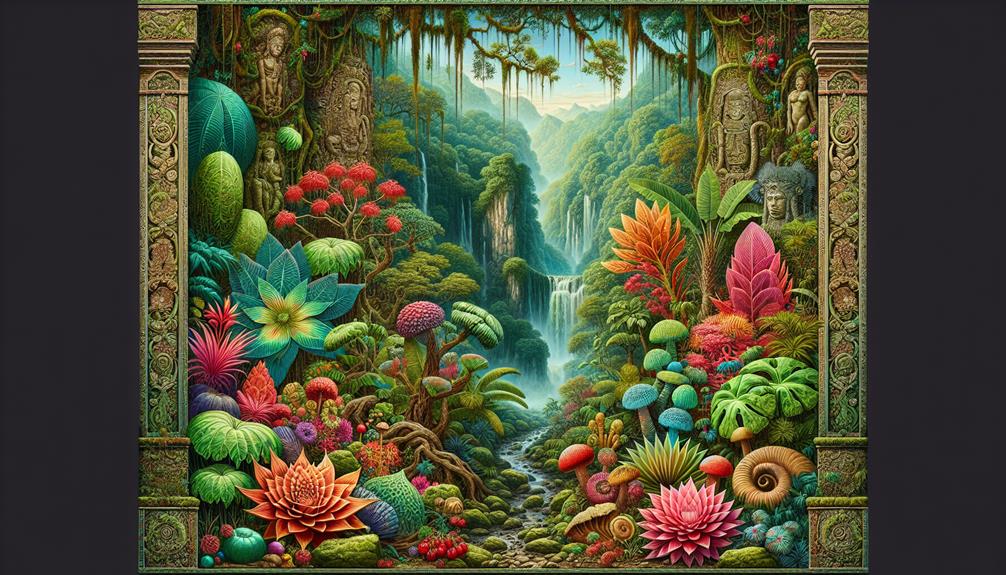When you think of psychedelic plants, images of ancient rituals and modern therapies might come to mind. These remarkable organisms have woven themselves into the fabric of human history, serving as tools for healing and exploration. From the sacred ceremonies of indigenous cultures to contemporary studies spotlighting their therapeutic potential, the journey of these plants is both fascinating and complex. As you explore their historical Roots and cultural significance, you’ll uncover surprising connections that challenge your perceptions of nature and consciousness. What hidden truths about our relationship with these plants are waiting to be revealed?

Historical Overview
Throughout history, cultures around the globe have harnessed the transformative power of psychedelic plants for spiritual rituals, healing, and self-discovery.
You might find it fascinating that ancient civilizations, from the Aztecs to the Indigenous tribes of the Amazon, utilized these plants in their ceremonies. They believed that substances like psilocybin mushrooms and ayahuasca opened portals to other domains, allowing them to connect with deities or ancestors.
In ancient Greece, the Eleusinian Mysteries featured kykeon, a barley drink believed to contain psychoactive properties. Participants experienced profound insights, fostering community and spiritual growth.
Fast forward to the 20th century, and you’ll see a resurgence of interest in these natural psychedelics during the counterculture movement. Figures like Timothy Leary popularized their use, asserting that these plants could tap human potential.
As you explore this historical tapestry, you’ll notice how the relationship with psychedelic plants has evolved, yet the core intent—seeking understanding and healing—remains. Today, modern research is rekindling interest in their therapeutic benefits, suggesting that the wisdom of our ancestors might hold relevance in contemporary mental health practices.
Cultural Significance
What makes psychedelic plants so culturally significant is their ability to bridge the gap between the physical and spiritual worlds, offering unique insights and healing experiences that have shaped rituals and traditions for centuries. Across various cultures, these plants have served as sacred tools for connecting with the divine, facilitating personal transformation, and fostering communal bonds.
Imagine stepping into a vibrant shamanic ceremony, where the air is thick with the scent of burning sage and drums pulse with rhythmic energy. Participants sip on a brew, their senses heightening, leading to profound revelations that transcend everyday consciousness.
In indigenous practices, such as those of the Amazonian tribes, these plants are revered as teachers, guiding individuals through the complexities of existence and the mysteries of the universe.
In addition to personal growth, psychedelic plants have played a role in social cohesion, often bringing communities together in shared experiences of healing and understanding.
You can see this in the rituals of the Mazatec people, who use psilocybin mushrooms to connect with ancestors and seek guidance. Their cultural significance endures, reflecting humanity’s timeless quest for connection, meaning, and transcendence.
Modern Applications
Many researchers and therapists are exploring the modern applications of psychedelic plants, recognizing their potential to transform mental health treatment and enhance personal well-being. Today, substances like psilocybin mushrooms and ayahuasca are gaining traction in clinical settings. They’re being studied for their ability to alleviate depression, anxiety, PTSD, and even addiction.
Imagine stepping into a serene environment, where a trained guide helps you navigate your inner landscape during a psychedelic experience. This approach can lead to breakthroughs in understanding oneself, allowing emotional blockages to dissolve. You might find that these experiences foster profound insights, helping you to confront and heal past traumas.
Therapeutic sessions often combine these substances with psychotherapy, creating a holistic method for healing. Many participants report lasting changes in their mood and outlook on life, often describing an increased sense of connection to themselves and others.
Explore Further: The World of Psychedelic Plants
The history and uses of psychedelic plants reveal a rich tapestry of cultural, spiritual, and medicinal practices across various societies. These plants have played significant roles in rituals, healing, and personal exploration. To delve deeper into the fascinating world of psychedelic plants, we invite you to read a detailed article on psychedelic plants. This comprehensive piece explores their historical contexts, cultural significance, and diverse applications.